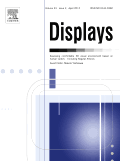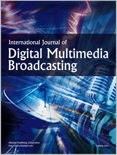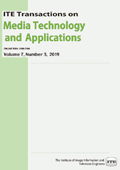
DISPLAYS
Scope & Guideline
Shaping Tomorrow's Digital Interactions
Introduction
Aims and Scopes
- Display Technology Innovations:
Research on novel display technologies including OLED, micro-LED, holographic displays, and their applications across various domains such as consumer electronics, medical imaging, and automotive. - Human-Computer Interaction (HCI):
Studies exploring user interaction, ergonomics, and cognitive responses related to display interfaces, including the impact of design choices on usability and user experience. - Image Processing and Enhancement Techniques:
Investigations into image processing methods for enhancing visual quality, including super-resolution, dehazing, and image segmentation, often leveraging deep learning techniques. - Virtual and Augmented Reality Applications:
Exploration of display technologies in virtual and augmented reality contexts, focusing on user experience, visual fidelity, and the mitigation of motion sickness. - Multimodal Interaction and Interface Design:
Research on integrating visual displays with other sensory modalities (e.g., auditory, haptic) to create more immersive and effective user interfaces.
Trending and Emerging
- Artificial Intelligence in Display Systems:
The integration of AI and machine learning techniques for optimizing display performance and enhancing user interaction is increasingly prevalent in recent studies. - 3D and Holographic Displays:
Research focusing on three-dimensional and holographic display technologies is gaining momentum, driven by advancements in optics and user demand for immersive experiences. - Health and Ergonomics in Display Usage:
There is a growing emphasis on understanding the health impacts of display usage, including visual fatigue and ergonomics, particularly in the context of prolonged screen time. - Interactive and Adaptive Displays:
Emerging designs that allow for adaptive interfaces and interactivity are becoming a significant focus, reflecting a trend towards personalized user experiences. - Sustainable and Energy-Efficient Display Technologies:
Research is increasingly addressing the environmental impact of display technologies, with a focus on energy-efficient designs and sustainable materials.
Declining or Waning
- Traditional 2D Display Technologies:
Research on conventional flat-panel displays is becoming less prominent as advancements in more immersive and interactive display technologies gain traction. - Physical Display Materials:
Studies focused solely on the materials used in display construction, such as glass and plastics, are decreasing as research shifts towards more complex systems and applications. - Basic Optical Principles:
Papers that concentrate on fundamental optical theories without application to modern technology are less frequent, as the field advances towards practical, application-driven research. - Static Image Quality Assessment:
The focus on static image quality metrics is waning, with a shift towards dynamic and contextual assessments of image quality in real-time applications.
Similar Journals

JOURNAL OF COMPUTER SCIENCE AND TECHNOLOGY
Fostering Breakthroughs in Technology and ApplicationJOURNAL OF COMPUTER SCIENCE AND TECHNOLOGY, published by Springer Singapore Pte Ltd, is a pivotal platform in the rapidly evolving realms of computer science and technology. With an ISSN of 1000-9000 and an E-ISSN of 1860-4749, this journal encompasses a diverse array of topics including computational theory, hardware and architecture, software engineering, and applications of computer science. Spanning over three decades from 1986 to 2024, it boasts an impressive standing within academic circles, ranking in the Q2 quartile across several key categories and achieving notable placement in Scopus metrics. Although this journal operates under a subscription-based model, it remains a crucial resource for researchers, professionals, and students seeking to advance their knowledge and contribute to discussions in computer science. The JOURNAL OF COMPUTER SCIENCE AND TECHNOLOGY is committed to fostering innovation and scholarly communication in the field, encouraging submissions that contribute substantive advancements in theory and application.

Frontiers in Computer Science
Empowering researchers to share and innovate in computer science.Frontiers in Computer Science is a premier open-access journal published by Frontiers Media SA that has rapidly established itself as a prominent platform for scholarly research in the diverse and evolving field of computer science. With a notable impact factor reflecting its high citation rates, this journal aims to disseminate innovative findings and groundbreaking studies across multiple subdisciplines, including Computer Science Applications, Computer Vision and Pattern Recognition, and Human-Computer Interaction. Since its inception in 2019, and with a consistent trajectory from 2019 to 2024, it has garnered accolades, achieving Q2 ranking in several categories and an impressive Q1 in miscellaneous areas of computer science. Researchers, professionals, and students alike are encouraged to contribute to this dynamic journal that serves as a vital resource for advancing knowledge and fostering collaborative dialogue in the global computer science community. Frontiers in Computer Science is committed to providing open access to research, promoting unrestricted sharing of ideas and fostering innovation at the intersection of technology and society.

MULTIMEDIA TOOLS AND APPLICATIONS
Exploring the forefront of technology and communication.MULTIMEDIA TOOLS AND APPLICATIONS, published by Springer, is a highly regarded journal in the fields of Computer Networks and Communications, Hardware and Architecture, Media Technology, and Software. Since its inception in 1995, this journal has established itself as a vital platform for disseminating innovative research and developments, maintaining a prominent position evidenced by its Q2 and Q1 rankings across various categories as of 2023. With an ISSN of 1380-7501 and an E-ISSN of 1573-7721, it continues to attract high-quality contributions from scholars and practitioners worldwide. Although it does not currently offer Open Access options, its impact is reflected in impressive Scopus rankings, placing it in the top quartiles in multiple categories, including a remarkable 10th rank in Media Technology. As the field evolves rapidly, the journal’s objectives encompass advancing multimedia technologies and exploring their multifaceted applications, making it an essential resource for researchers, professionals, and students seeking to stay at the forefront of this dynamic discipline. For more information, visit the journal's page to explore recent publications and submission guidelines.

Multimodal Technologies and Interaction
Enhancing Interaction Through Innovative Research.Multimodal Technologies and Interaction, published by MDPI since 2017, is an esteemed open-access journal based in Switzerland, dedicated to the exploration and advancement of innovative multimodal systems that enhance user experience across various digital platforms. With its commitment to disseminating high-quality research in diverse areas such as Computer Networks and Communications, Human-Computer Interaction, and Neuroscience, the journal has rapidly established itself within the academic community, achieving a commendable position in Scopus rankings including Q2 in both Computer Networks and Communications and Computer Science Applications. As an essential resource for researchers, professionals, and students alike, Multimodal Technologies and Interaction fosters interdisciplinary dialogue and supports the development of cutting-edge technologies, ensuring that advancements in multimodal interaction are accessible to a global audience. Scholars can benefit from its Open Access format, allowing unrestricted access to influential studies that shape the future of technology and interaction design.

International Journal of Digital Multimedia Broadcasting
Unlocking Insights in Communication and EngineeringThe International Journal of Digital Multimedia Broadcasting is a leading scholarly platform dedicated to the interdisciplinary exploration of digital multimedia broadcasting, published by HINDAWI LTD. With an ISSN of 1687-7578 and an E-ISSN of 1687-7586, this Open Access journal has made significant strides since its inception in 2008, ensuring wide accessibility and dissemination of research. Based in the United States, at Adam House, 3rd Flr, 1 Fitzroy Sq, London W1T 5HF, England, the journal covers a range of topics relevant to Communication, Electrical and Electronic Engineering, and Media Technology, boasting impressive Scopus rankings that highlight its influence in these fields. As part of the Q3 category in Communication and Electrical Engineering, and Q2 in Media Technology for 2023, the journal serves a vital role in fostering the understanding of technological advancements and their applications in multimedia broadcasting. Researchers, professionals, and students are encouraged to contribute to and benefit from the journal's rich repository of knowledge, paving the way for innovative developments in this dynamic industry.

ITE Transactions on Media Technology and Applications
Shaping the Future of Media ApplicationsITE Transactions on Media Technology and Applications is a premier academic journal published by the esteemed Institute of Image Information and Television Engineers (INST IMAGE INFORMATION & TELEVISION ENGINEERS), located in Tokyo, Japan. With an ISSN of 2186-7364, this journal has been a vital platform for disseminating innovative research and practical applications in the fields of media technology, computer graphics, and signal processing since its inception in 2013. It is notable for its ranking within the Q3 and Q2 quartiles in various categories, reflecting its growing influence and importance in the academic community. Although it operates under a subscription model, the journal continuously aims to foster collaboration and knowledge sharing among researchers, professionals, and students alike. With a commitment to publishing high-quality studies that address the latest advancements and challenges in media technology and its applications, ITE Transactions plays a significant role in shaping the discourse in these vital areas of research.

Frontiers in Virtual Reality
Pioneering Research in Human-Computer InteractionFrontiers in Virtual Reality, published by FRONTIERS MEDIA SA, is a leading open-access journal that has been at the forefront of the burgeoning field of virtual reality since its establishment in 2020. Based in Lausanne, Switzerland, this journal provides a vital platform for researchers, professionals, and students eager to explore and disseminate innovative findings related to virtual environments, immersive technologies, and human-computer interaction. With a commendable 2023 ranking placing it in the Q2 quartiles across prestigious categories such as Computer Graphics, Computer-Aided Design, and Human-Computer Interaction, the journal is highly regarded for its rigorous peer-review process and commitment to promoting scholarly communication. Frontiers in Virtual Reality not only advances the understanding of immersive experiences but also encourages interdisciplinary research that bridges the gaps between technology and human interaction. As an essential source of knowledge and a discussion forum for cutting-edge advances, this journal continues to shape the future of virtual reality research with easily accessible content and a responsive editorial approach.

ACM Transactions on Applied Perception
Pioneering Research at the Crossroads of Psychology and ComputingACM Transactions on Applied Perception is a leading journal published by the Association for Computing Machinery, focusing on the intersection of perception science and computational methods. With an ISSN of 1544-3558 and an E-ISSN of 1544-3965, this esteemed publication has been a vital resource for innovators and researchers since its establishment in 2004. It operates within the ambit of Computer Science and the realms of Experimental and Cognitive Psychology, boasting a commendable impact factor and category rankings, including Q2 in Computer Science (miscellaneous) and Q3 in both Experimental and Cognitive Psychology and Theoretical Computer Science. The journal's scope encompasses a plethora of studies aimed at understanding human perception through computational lenses, making it an essential platform for scholarly exchange. Although it does not currently offer an Open Access option, its extensive reach and rigorous peer-review process ensure high visibility and impact in the academic community. By fostering collaboration across disciplines, ACM Transactions on Applied Perception encourages advancements that bridge perceptual research with practical applications, making it invaluable for researchers, professionals, and students engaged in this dynamic field.

Journal of Electromagnetic Engineering and Science
Advancing the Frontiers of Electromagnetic InnovationThe Journal of Electromagnetic Engineering and Science (ISSN: 2671-7255, E-ISSN: 2671-7263) is a premier Open Access journal published by the Korean Institute of Electromagnetic Engineering & Science. Since its establishment in 2001, it has been dedicated to advancing knowledge in the fields of Electrical Engineering, Electromagnetic Theory, and Communications, making significant contributions to both academia and industry. The journal holds an impressive Q2 quartile ranking in notable categories such as Computer Networks and Communications and Electrical and Electronic Engineering as of 2023, reflecting its robust scientific impact and reputation. It is indexed in Scopus, with commendable rankings in multiple fields, enhancing its visibility and reach among researchers. The journal's open-access model ensures that cutting-edge research is accessible to a global audience, fostering collaboration and innovation. Researchers, professionals, and students in the domain are encouraged to contribute and engage with high-quality articles that cover the latest advancements and trends in electromagnetic engineering and associated sciences.

IEEE Consumer Electronics Magazine
Discovering Breakthroughs in Electronics and ComputingIEEE Consumer Electronics Magazine, published by the IEEE INSTITUTE OF ELECTRICAL AND ELECTRONICS ENGINEERS INC, is a premier journal dedicated to disseminating cutting-edge research and insights in the fields of consumer electronics, engineering, and computer science. With an ISSN of 2162-2248 and an E-ISSN of 2162-2256, this quarterly publication serves as an essential resource for practitioners, researchers, and academics alike, highlighting innovative advancements and applications. As a testament to its scholarly impact, the journal ranks in the Q2 quartile across multiple categories, including Computer Science Applications, Electrical and Electronic Engineering, Hardware and Architecture, and Human-Computer Interaction, reflecting its crucial role in shaping the landscape of consumer technology. Although not an open access journal, it offers a multitude of access options for its readers and has successfully navigated the evolving technology sector since its establishment in 2012. For those keen to further their understanding of consumer electronics, this magazine is not just a publication, but a hub for knowledge and innovative thinking.